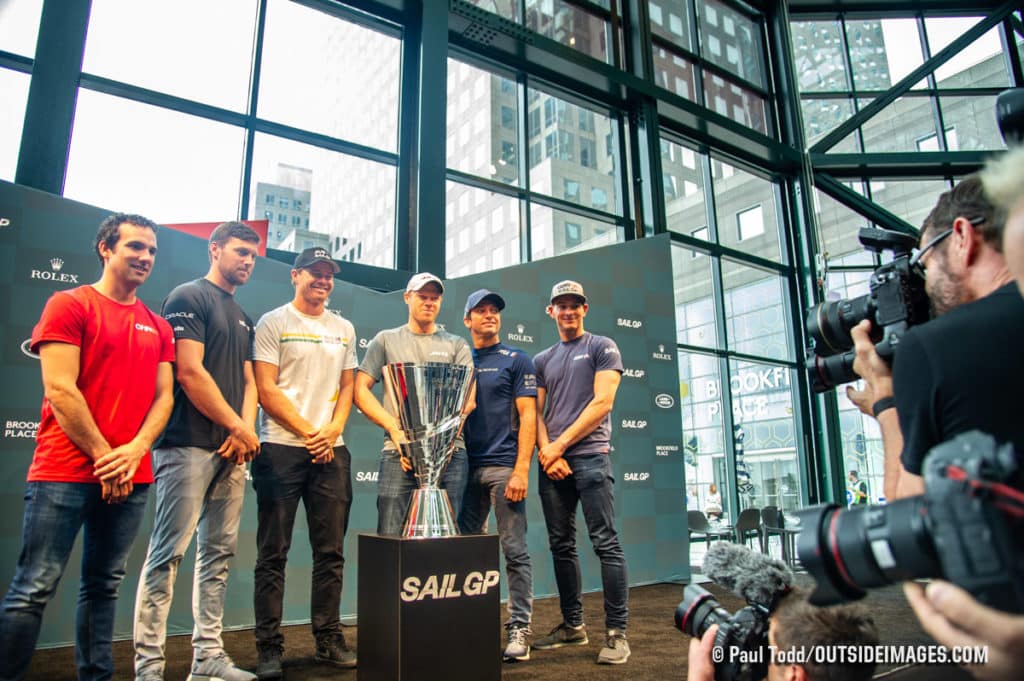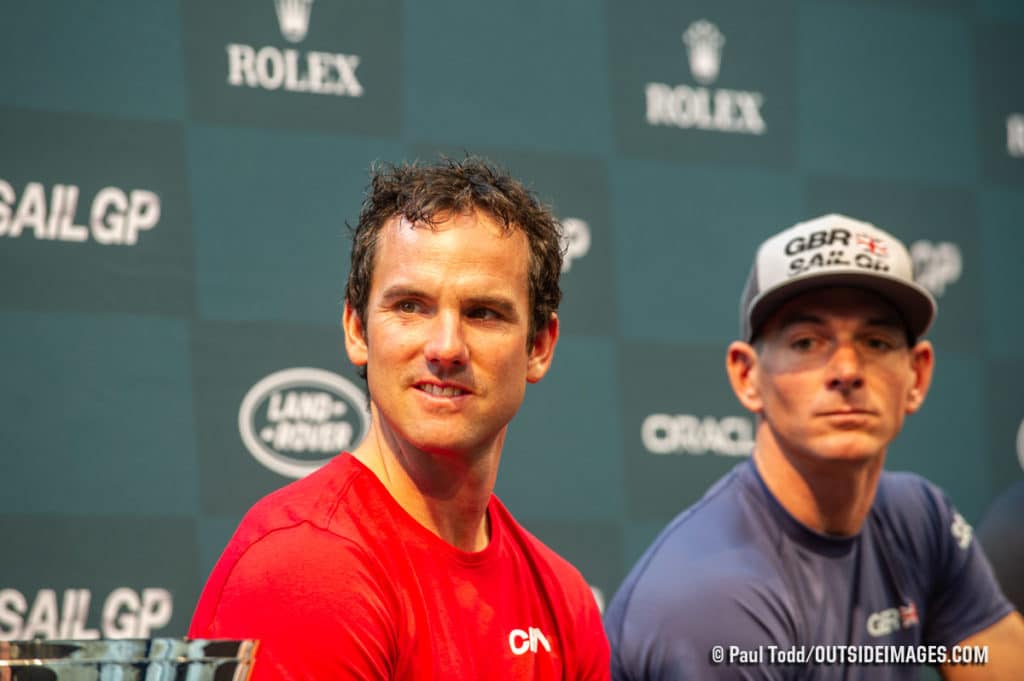
Phil Robertson, the animated New Zealand skipper of SailGP’s China Team, shares his feelings about racing on the Hudson River, which flows through the heart of New York City. Barely a 1.5-miles wide, it’s the smallest, most confined racecourse of the new SailGP series, with the New Jersey shoreline to the west and Manhattan’s concrete jungle to the east.
“You have a venue that’s spectacular, but it’s not really designed for one of these boats to be sailing there,” Robertson says, speaking for himself and SailGP’s five other skippers at the opening press briefing on Thursday afternoon before a scheduled practice race, “and we’re throwing six of them on this course, so we’re probably all crapping our pants here knowing what we’ll be pushed off the dock toward.”
Robertson is responding to a question from the moderator about the first day’s forecast for brisk northerly winds.
“It will be outrageous,” Robertson continues with a grin and shifting in his stool. “Ah…yeah…we’re probably all a bit nervous of what’s going to come tomorrow, but it will probably be something you’ve never seen before.”
US SailGP Team USA skipper Rome Kirby, who sailed the America’s Cup World Series here three years ago as a crewmember with Oracle Racing Team USA, has been practicing since Monday and boasts of a 60-minute dry lap on the foils of their F50—in 10 knots of wind—knows how quickly the racecourse will shrink if the forecast comes true.
“In 10 knots it’s tiny,” he says of the race venue. “In 30 knots, I don’t know how we’re going to do it.”
Without any hard wind limits, it would be on SailGP officials to make the call whether to race or not, but if it were up to Kirby, would he conduct the races in 25 knots sustained?
“Personally, I wouldn’t,” he says with a grin and a pshaw. “We sailed in 22 knots in San Francisco, which is all great, but when you have puffs you can’t see coming out of the buildings and accelerating, and a course this small, with spectator fleet all around it, with no runway to run off…”
The stronger winds of SailGP’s San Francisco races in May suited the American squad, which put in a much better performance than they did in Sydney, Australia, in February. But San Fran and New York are night and day, all things considered.
“We’re not slow,” Kirby says. “We just need to clean up details. We can’t lead around the bottom mark in two of the five races and not put one away.”
Kirby says he was flying the boat through the leeward mark roundings, but his knuckles kept hitting the boat’s cockpit coaming during the maneuvers, so he’s passed some of the boat’s flight control to his tactician, Taylor Canfield. Other teams have had the same issue, he says, and have defaulted to similar division of labor.
Performance data from the boats in San Francisco confirms Kirby’s claim that the American squad was consistently the fastest team on the water on race days, but the Japanese team, led by its Australian skipper, Nathan Outteridge, trumped with better starts and consistently better sailing in nearly every race.
At today’s press conference, Team Australia skipper Tom Slingsby stood firm in his belief that it was his team that won the San Francisco regatta as opposed to the Japanese team losing it (in one single mark-rounding boathandling error in the winner-take-all final match race). Outteridge, however, says the performance data from the boats says otherwise: in the VMG column, the Japanese were best in seven of nine races.
“VMG wins races,” says Kirby, “we are still racing sailboats.”
Terabytes of performance data, audioAudio, and video and data coming off the boats and shared amongst the teams, is allowing the sailors and coaches to analyze their each other’s performance live and in-depth between races and overnight. Adjustments are made every step of the way, Outteridge says.
From onboard video, they can also see who’s doing what in the boat during the maneuvers and which of the numerous flight control buttons are getting pushed, as well as what’s being said.
“In San Francisco, we were looking at the Australians and the British, especially, looking at tacking, jibing, every maneuver, and VMG loss, because every time you do a maneuver you’re losing something,” he says. “In the loss, you can look at every single variable: how fast you turn the boat, what you do with the daggerboards, when the rudders are swapping, when you’re popping the wing, and all sorts of other stuff.
“Also, when doing straight-line sailing, we’re looking at everyone’s ride height, wing trim and camber. I know the other teams are looking at us, but we have to look at the other teams and what they’re doing better than us and apply that to the next race.”
As an example, he points to the American team, who he says was tacking best in San Francisco. “They were always foil tacking. We weren’t really analyzing them, but after the event, we could see seeing most of their gains were from tacking. They were pushing the lift in the tacks much more, and on the exit, they were keeping the leeward hull much, much higher. You can see it in the video, but we can then go back and look at the data and see how they’re doing it. It looks like they’re popping the wing earlier, which keeps the inside hull much higher.”
From onboard video, they can also see who’s doing what in the boat during the maneuvers and which of the numerous flight control buttons are getting pushed, as well as what’s being said. Being able to listen in on competitors’ comms, says Outteridge, is a new and powerful tool in terms of understanding what makes each of them tick.

“In San Francisco, with Tom [Slingsby], all he focused on was us,” he says, “it was always Nathan this and Nathan that. Maybe that’s why he was struggling early on because he was focusing too much on us. On the second day, he spoke less about us and more about the fleet and was much better.”
On the other hand, Outteridge’s rivals keyed in on the Japanese team’s strengths and weaknesses, and San Francisco, again, provides a clear example. On the first day of racing, the Japanese team dominated every start, but the next day was a different story.
“It was an open course, the wind was consistent, and we have software that helps with starting,” Outteridge says, “so we were trusting the software to help us come in with pace. We were often a half-length back on the fleet, but 5 knots faster across the line. If you start in the middle and get in early with the fleet, you lose all your options to accelerate. On Sunday, everyone took a step back, did the similar thing and took that advantage away.”
It won’t be so easy to get away with runaway starts here in New York, however, he says. The starting software can’t account for the unpredictable wind funneling through tall and irregular buildings. “We’ll have to use our eyes a lot more,” he says. “Tomorrow, if the forecast is right, it could be 5 knots or 20 knots. You can be in a good spot and go to pull the trigger, but suddenly can’t fly a hull because you’re in a lull and now you’re super late.”









